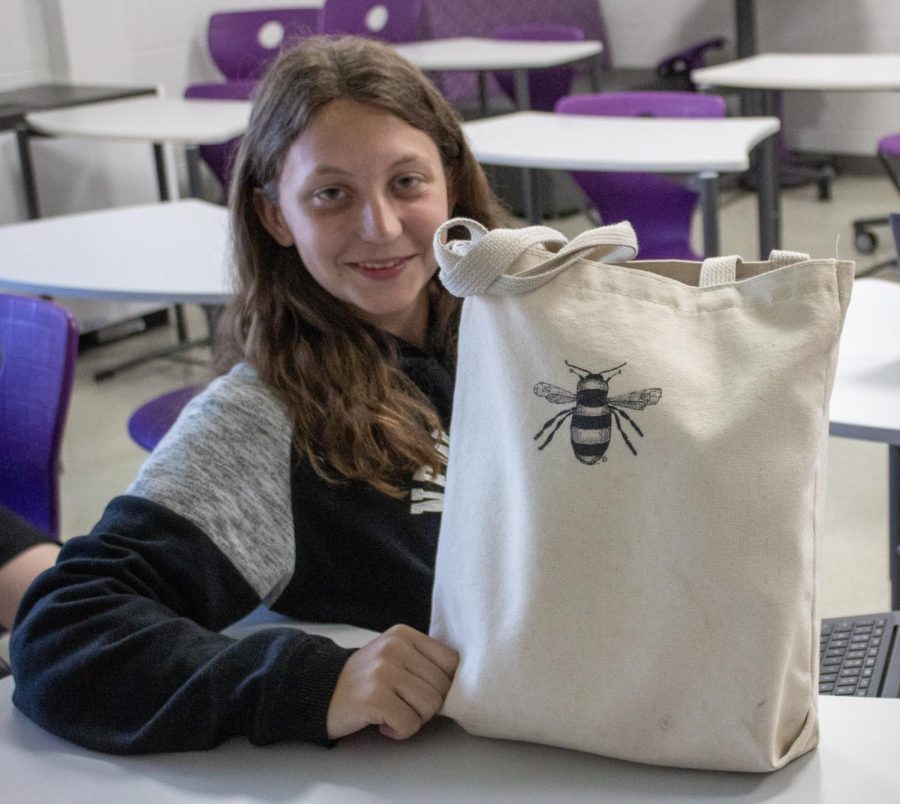Danni Fritz with her bag from a farmers market.
The effects of fast fashion




Have you ever scrolled through Instagram and been intrigued by images of colorful, trendy clothes, ones that are not like anything you’d see in local stores? Then, when you click the link, the prices seem ridiculously low. Why wouldn’t you order a few new pieces?
Many companies that manufacture fast fashion use toxic dyes, and synthetic chemicals which enter into the water systems. Over 11 million tons of clothing are thrown away annually in the United States because people who purchase these items of clothing just toss them after a few wears. Only 15% of clothing is recycled, the rest of your clothing you don’t recycle ends up in the landfill. Synthetic materials like polyester, take up to 200 years to decompose. These materials are used in over 69% of clothing today. Some ways we can help this problem are choosing to clothe with natural fibers or semi-synthetic material, recycling, or just buying less clothing in general.
The apparel made by fast fashion companies pollutes the oceans and waterways. Did you know that making one pair of jeans uses 7,500 liters of water annually and that 500,000 tons of plastic microfibers are tiny thread-like threads made of natural and synthetic fibers like polyester, rayon, and acrylic are thrown into the ocean annually? Each time you wash your clothes over 700.0 microplastics are released into the water. Scientists discovered that plastic is eaten by small aquatic organisms, those organisms are eaten by small fish, and those smaller fish are eaten by bigger fish. This means the plastic that is in our food chain with some of the things we eat. So how can you improve this? First, you can wash your clothes only when you need to, wash them at lower temperatures, and buy more natural fibers.
Between 5% and 10% of greenhouse gasses are released from processes in the fast fashion industry. The fashion industry consumes energy throughout the transportation, production, and manufacturing of products. The majority of our clothes are made of synthetic fibers, which are made with fossil fuels causing these clothes to be made using more energy. Many countries use coal as their main source of energy; these countries include China, Bangladesh, and India. Coal energy is the dirtiest kind of energy when it comes to carbon emissions. Here are ways we can avoid releasing greenhouse gasses into the atmosphere. Choose natural fibers, buy less, better quality, mend clothes, and buy clothing from countries powered by renewable energy.
Fast fashion companies not only pollute the environment, but they also require their employees to work 14 to 15-hour days, seven days a week. In addition to working such long hours, they are underpaid. In Bangladesh, the average hourly wage is roughly 33 cents; while in India, it is approximately 58 cents. Sweatshops not only pay much less than the minimum wage, but the working conditions are horrible. Many sweatshops can be located in underdeveloped countries with weak labor laws. Many of the workers in these sweatshops die on the job as a result of poor treatment.
So how can high school students be more environmentally conscience? Iyla Weeks, a sophomore, offers suggestions on how she would advise people to steer clear of fast fashion. “My suggestion to avoid fast fashion is to buy second-hand clothing; Goodwill is my personal favorite.” Weeks continues, “You should also try to stay away from the large fast fashion companies as well.”
Avoid shopping at Urban Outfitters, Gap, Zara, Forever 21, Shein, and H&M if you don’t want to buy fast fashion. Even if you were unaware that some of your favorite brands were fast fashion, there are still other places you can buy them, including second-hand at Goodwill and other local thrift stores or, even better, online at websites like Depop, Poshmark, and eBay, to name a few. Junior Aidan Grandy adds, “When I have clothes I want to get rid of, I either sell them online or donate them to thrift shops. I make an effort to avoid falling into fast fashion and purchasing an excessive amount of clothing online. I shop at numerous online secondhand stores, but Depop is my favorite. Grandy continues, “I believe that this is something that we need to work on together since we shouldn’t be using fast fashion in the first place.”
Senior Autumn Cornell says, “The Goodwill bins are her favorite thrift store. The majority of the clothes you find are affordable, reusable, and better for the environment. You can find some great finds in the bins if you dig thoroughly to the bottom of the bin. The majority of the clothing at Goodwill is given by grandmothers and adults, despite the fact that I mix many different trends into my outfits. I don’t have a certain fashion; therefore, finding items I enjoy is easier for me.”
Our environment has been damaged by the fast fashion industry in a number of ways. One piece of fast fashion clothes requires a lot of water to produce, emits 5–10% of greenhouse gases, and takes 200 years to degrade. Additionally, the employees are not treated well. Here are some tips for avoiding fast fashion collectively: shop from sustainable labels, buy better quality, consider your wardrobe choices before discarding them, and purchase used clothing.
